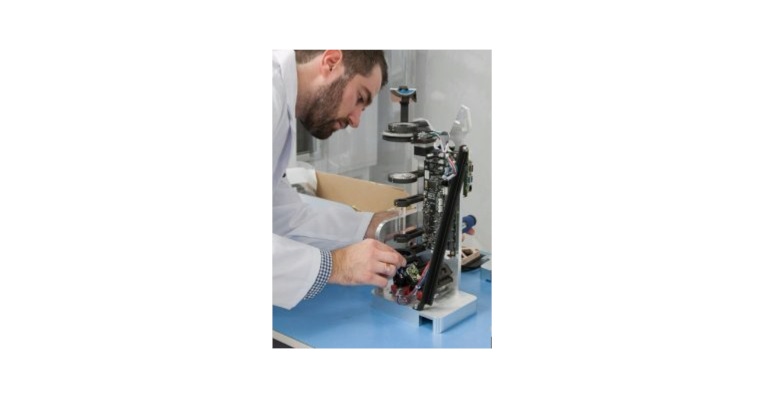Developers of point-of-care assays and readers must consider end-user capabilities, use settings, and the purposes of testing.

Optical imaging techniques offer a number of important advantages when developing medical devices for diagnosis at the point of care. Optical imaging can provide real-time and high-resolution microscopic and macroscopic information leading to rapid and accurate diagnosis in modern point-of-care optics design for testing infectious diseases.
Significant production and manufacturing advances in optoelectronics (such as silicon photo multipliers), micro-optics and optical micro-electromechanical-systems (MEMS) have led to incredible miniaturization of optical imaging platforms. The resulting reduction in cost allows for unprecedented developments in essentially disposable high-fidelity optical reader systems for infectious diseases diagnostic platforms.1 Integration of microfluidic systems2 with these emerging optical detection platforms also paves the way for next generation lab-on-a-chip diagnostic technologies for use at the point of care across a spectrum of target product profiles.
Point-of-Care Infectious Diseases Diagnostics Background
For years, point-of-care infectious diseases diagnostics has been a steadily growing development field. Pre-COVID-19, the compound annual growth rate (CAGR) of POC testing for the infectious disease over the forecast period was expected to be around 10.3%.3 Post COVID-19, this is likely to be an order of magnitude higher with every biotech industry, government, and academic institute scrambling to develop rapid, accurate diagnostic tools to detect and monitor transmission of SARS CoV-2.
POCT Definition
The term ‘point of care’ often gets thrown around and, as medical device developers, we hear this term all the time. But what does it actually mean? The definition that I like comes from Prince et al (2004): Point-of-care testing (POCT) can be defined as the “provision of a test when the result will be used to make a decision and to take appropriate action which will lead to an improved health outcome.” 4 Taking this a step further by capping the time frame to “within the same encounter or visit” fully captures the essence of what POCT is.
POCT can be defined as the provision of a test when the result will be used to make a rapid decision and to take appropriate action, which will lead to an improved health outcome within the same encounter … the key objective of POCT is to produce a result more quickly.
B-ASSURED
This definition is often further constrained by the principles of B-ASSURED. This acronym set forth by the World Health Organization5 states:
B* | Biohazardous |
A | Affordable |
S | Sensitive |
S | Specific |
U | User Friendly |
R | Rapid and Robust |
E | Equipment-Free |
D | Delivered |
*The B-part stands for biohazard. My lab has added this to the acronym because it highlights what we believe to be the most important element in infectious disease diagnostics—the biohazard you are trying to detect. Pre-COVID-19 this was less obvious; in a world in which we are wearing surgical masks and gloves to buy groceries, it is now an obvious design consideration that some element of the POCT will come in contact with the agent and therefore need to be disposable. Perhaps even the entire device needs to be disposable. This is an important design consideration not to be taken lightly.
Another consideration is whether to design devices so that they could be utilized by minimally trained users with no equipment, or possibly no electricity, performing a diagnostic test with no laboratory equipment and minimal disposable tests such as a lateral flow device (think pregnancy test kit). The optics systems development could possibly be limited to the MARK-I eyeball comparing a color change or development of two lines instead of one on the lateral flow strip.
Target Product Profile (TPP)
Restricting POCT to really inexpensive and equipment-free tests imposes barriers for use of newer technologies such as cartridge-based POC nucleic acid amplification tests and hand-held devices such as mobile phone-based technologies.6 More accurately, it is far better to consider POCT technologies in the context of a target product profile (TPP). In the context of infectious disease diagnostics, this term (often reserved for the world of product development engineering) is nicely defined by the World Health Organization as a term that outlines the desired ‘profile’ or characteristics of a target product that is aimed at a particular disease or diseases. TPPs state intended use, target populations, and other desired attributes of products, including safety and efficacy-related characteristics. Such profiles can guide product development7 and optics selection and design for the device.
The TPP considers not just the device sophistication, but rather a spectrum which considers the technology complexity, user skill level, and setting. This spectrum is nicely presented by Pai et al (2012),8 which I highly encourage you to read.
In a framework that considers TPP, the definition of POC test is agnostic of the device or setting. A dipstick could be used by a minimally trained person outside traditional clinical settings and deliver actionable diagnostic results. That same test could be used by a highly skilled technician in clinical central lab setting to deliver actionable diagnostic results through a complex interconnected lab information management system (LIMS). In either setting, each user is utilizing a point-of-care test with actionable results. Likewise, if the device is a complex system (such as a modern high-throughput molecular diagnostic system like a COBAS 8800) that delivers a test result that will be used to make a decision and to take appropriate action leading to an improved health outcome within the same encounter or visit, that test is considered a true point-of-care test.
Depending on the end-user and the actual setting, the purpose of POC testing may vary (i.e., diagnosis, treatment, monitoring, airport screening, at home use). This, of course, has critical implications for the assay and reader developers. For example, the tests across the use spectrum may have remarkably different sensitivity, specificity, and accuracy requirements. Throughput and downstream information handling will also have implications for test developers. Selection and design of the appropriate point-of-care optics design for the modern POCT will be driven by having a firm understanding of all of these considerations.
References
Kazakoff, Peter, "Silicon Photomultipliers: Low-Light Sensing in Medical Instrumentation." https://starfishmedical.com/blog/silicon-photomultipliers-low-light-sensing-in-medical-instrumentation/
Gutierrez, Lorenzo, "Translating Point-of-Care Assays to Microfluidic Cartridges." https://starfishmedical.com/blog/translating-point-of-care-assays-to-microfluidic-cartridges/
"Infectious Diseases In Vitro Diagnostics Market Size, Share & Trends Analysis Report By Product, By Application, By Technology (Immunochemistry, Molecular Diagnostics), By End Use, By Region, And Segment Forecasts, 2020 - 2027" http://www.grandviewresearch.com/industry-analysis/ivd-infectious-disease-market
Price CP, St. John A, Hicks JM (2004) Point-of-Care Testing. 2nd edition. Washington (D.C.): American Association for Clinical Chemistry.
Peeling RW, Mabey D (2010) "Point-of-Care Tests for Diagnosing Infections in the Developing World." Clin Microbiol Infect 16: 1062–1069.
Pai NP, Vadnais C, Denkinger C, Engel N, Pai M (2012) "Point-of-Care Testing for Infectious Diseases: Diversity, Complexity, and Barriers in Low- And Middle-Income Countries." PLOS Medicine 9(9): e1001306. https://doi.org/10.1371/journal.pmed.1001306
https://www.who.int/research-observatory/analyses/tpp/en/ accessed July 8, 2020
Pai NP, Vadnais C, Denkinger C, Engel N, Pai M (2012) "Point-of-Care Testing for Infectious Diseases: Diversity, Complexity, and Barriers in Low- And Middle-Income Countries." PLOS Medicine 9(9): e1001306. https://doi.org/10.1371/journal.pmed.1001306
About the Author(s)
You May Also Like




